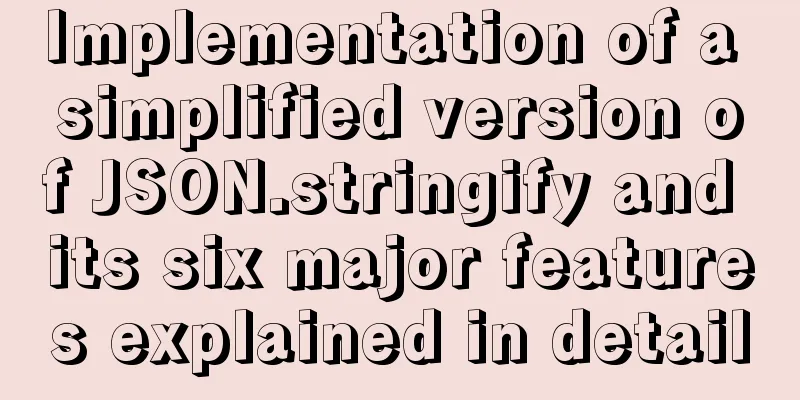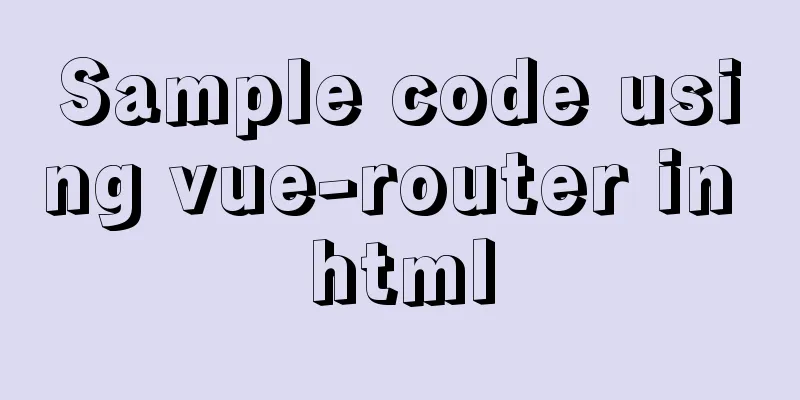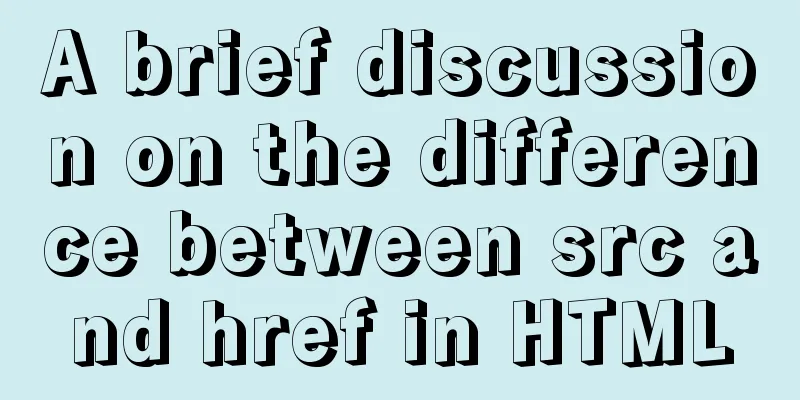Implementation of a simplified version of JSON.stringify and its six major features explained in detail

PrefaceJSON.stringify is a very frequently used API, but it has a feature that we need to pay attention to during use to avoid burying mines in the code program. So let's implement a simple version of the jsonStringify function together. Six features of JSON.stringifyFeature 1The wrapped objects of Boolean values, numbers, and strings are automatically converted into their corresponding original values during serialization. Now there is such an object:
const obj = {
bol: new Boolean(true),
num: new Number(1),
str: new String(1)
}
Use typeof to detect the data type of each attribute of obj typeof obj.bol; // object typeof obj.num; // object typeof obj.str; // object After serializing it
JSON.stringify(obj); // {"bol":true,"num":1,"str":"1"}
At this point, parse it to find the data type of each attribute const stringifyObj = JSON.parse(JSON.stringify(obj)); typeof stringifyObj.bol; // boolean typeof stringifyObj.num; // number typeof stringifyObj.str; // string Feature 2NaN, Infinity, -Infinity, and null are all treated as null during stringification
const obj = {
nan: NaN,
infinity: Infinity,
null: null,
};
JSON.stringify(obj); // {"nan":null,"infinity":null,"null":null}
Feature 3When an object is serialized, if it has a toJSON function, the value returned by this function is the result of the serialization of the entire object.
const obj = {
nan: NaN,
infinity: Infinity,
null: null,
toJSON() {
return "has toJSON function";
},
};
JSON.stringify(obj); // "has a toJSON function"
You can see that after serialization, only the return value of the toJSON function exists, and the rest of the data is ignored. ⚠️: Date data will be serialized normally because the toJSON function is deployed on Date, which can be found by printing Date.prototype.toJSON in the console
const obj = {
date: new Date(),
};
JSON.stringify(obj); // {"date":"2021-10-08T11:43:31.881Z"}
Feature 4Undefined, function, and symbol behave differently As an object key-value pair: As value:
const obj = {
undefined: undefined,
fn() {},
symbol: Symbol()
};
JSON.stringify(obj); // {}
As key:
const fn = function () {};
const obj = {
[undefined]: undefined,
[fn]: function () {},
[Symbol()]: Symbol()
};
JSON.stringify(obj); // {}
When undefined, function, and symbol are used as the key and value of an object, they will be ignored during serialization. ⚠️: This may change the original order of the objects, because the above three types of data will be ignored during serialization As an array value:
const arr = [undefined, function fn() {}, Symbol()];
JSON.stringify(arr); // [null,null,null]
When undefined, function, and symbol are used as array values, they will all be converted to null during serialization. When alone:
JSON.stringify(undefined); // undefined
JSON.stringify(function () {}); // undefined
JSON.stringify(Symbol()); // undefined
When undefined, function, and symbol exist alone, they will all be converted to undefined during serialization. Feature 5During serialization, only enumerable properties will be serialized, and non-enumerable properties will be ignored.
const obj = {
name: "nordon",
age: 18,
};
// Change age to a non-enumerable property Object.defineProperty(obj, "age", {
enumerable: false,
});
JSON.stringify(obj); // {"name":"nordon"}
⚠️: This will also change the original order of the objects Feature 6Circularly referenced objects will throw an exception during serialization
const obj = {
name: "nordon",
age: 18,
};
const p = {
name: 'wy',
obj
}
obj.p = p
JSON.stringify(obj);
This will cause the console to throw an exception:
Manually implement stringifyNow that we understand some of the features of JSON.stringify, we can implement a kack version based on these features. Before implementing it, use currying to encapsulate some tool functions for data type verification:
const currying = (fn, ...outParams) => {
// Get the number of parameters required by the fn function const paramsLen = fn.length;
return (...args) => {
// Collect all parameters let params = [...outParams, ...args];
// If the parameters do not reach the parameters required by fn, continue to collect parameters if (params.length < paramsLen) {
return currying(fn, ...params);
}
return fn(...params);
};
};
/**
* type: type - [object Array], [object Number], etc. * source: data source */
const judgeType = (type, source) => {
return Object.prototype.toString.call(source) === type;
};
const isUndefined = currying(judgeType, "[object Undefined]");
const isSymbol = currying(judgeType, "[object Symbol]");
const isFunction = currying(judgeType, "[object Function]");
const isObject = currying(judgeType, "[object Object]");
const isNull = currying(judgeType, "[object Null]");
Here is the code directly:
function jsonStringify(data) {
let type = typeof data;
if (isNull(data)) {
// null directly returns the string 'null'
return "null";
} else if (data.toJSON && typeof data.toJSON === "function") {
// Configure the toJSON function, directly use the data returned by toJSON and ignore other data return jsonStringify(data.toJSON());
} else if (Array.isArray(data)) {
let result = [];
//If it is an array, then each item in the array may be of different types data.forEach((item, index) => {
if (isUndefined(item) || isSymbol(item) || isFunction(item)) {
result[index] = "null";
} else {
result[index] = jsonStringify(item);
}
});
result = "[" + result + "]";
return result.replace(/'/g, '"');
} else if (isObject(data)) {
// Processing ordinary objects let result = [];
Object.keys(data).forEach((item, index) => {
if (typeof item !== "symbol") {
//If key is a symbol object, ignore if (
data[item] !== undefined &&
typeof data[item] !== "function" &&
typeof data[item] !== "symbol"
) {
//If the key value is undefined, function, or symbol, ignore result.push(
'"' + item + '"' + ":" + jsonStringify(data[item])
);
}
}
});
return ("{" + result + "}").replace(/'/g, '"');
} else if (type !== "object") {
let result = data;
//data may be a basic data type, handle it here if (Number.isNaN(data) || data === Infinity) {
//NaN and Infinity serialization returns "null"
result = "null";
} else if (isUndefined(data) || isSymbol(data) || isFunction(data)) {
// Since function serialization returns undefined, it is processed together with undefined and symbol return undefined;
} else if (type === "string") {
result = '"' + data + '"';
}
return String(result);
}
}
At this point, the simplified version of JSON.stringify is complete. Although it still lacks a lot of capabilities, it mainly provides an idea. The core comments have been annotated in the code, which can be understood together with the code and the above features. SummarizeThis is the end of this article about the implementation of JSON.stringify and its six major features. For more related simplified versions of JSON.stringify and its features, please search for previous articles on 123WORDPRESS.COM or continue to browse the following related articles. I hope everyone will support 123WORDPRESS.COM in the future! You may also be interested in:
|
<<: XHTML Basic 1.1, a mobile web markup language recommended by W3C
>>: Super detailed MySQL8.0.22 installation and configuration tutorial
Recommend
A brief discussion on Mysql specified order sorting query
Recently, I have been working on a large-screen d...
CSS3 gradient background compatibility issues
When we make a gradient background color, we will...
Detailed explanation of Vue px to rem configuration
Table of contents Method 1 1. Configuration and i...
Solution to the problem that Alibaba Cloud host cannot access the website using IP (solved by configuring security group rules)
I just bought an Alibaba Cloud host and couldn’t ...
Discuss the application of mixin in Vue
Mixins provide a very flexible way to distribute ...
How to do a good refactoring is not only refactoring the code but also refactoring life
It is really not easy to do a good reconstruction...
Analysis of several situations where MySQL index fails
1. Best left prefix principle - If multiple colum...
Automatic backup of MySQL database using shell script
Automatic backup of MySQL database using shell sc...
vue3 timestamp conversion (without using filters)
When vue2 converts timestamps, it generally uses ...
Install and configure ssh in CentOS7
1. Install openssh-server yum install -y openssl ...
Detailed explanation of the mysql database LIKE operator in python
The LIKE operator is used in the WHERE clause to ...
Pure CSS allows child elements to break through the width limit of parent elements
In writing styles, we can often see this situatio...
Use JavaScript to create page effects
11. Use JavaScript to create page effects 11.1 DO...
WeChat applet implements a simple handwritten signature component
Table of contents background: need: Effect 1. Ide...
Detailed explanation of the implementation method of database multi-table connection query
Detailed explanation of the implementation method...









